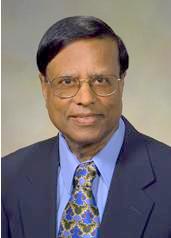Raj Mittra: Difference between revisions
(Created page with "== Biography == Professor of Electrical Engineering and director of the Electromagnetic Communications Laboratory at Penn State University in University Park, Pennsylvania, Raj...") |
No edit summary |
||
| Line 1: | Line 1: | ||
== Biography == | == Biography == | ||
[[Image:APS PHOTO raj.jpg|thumb|right]] | |||
Professor of Electrical Engineering and director of the Electromagnetic Communications Laboratory at Penn State University in University Park, Pennsylvania, Raj Mittra has made fundamental contributions to electromagnetics through his research skills and as a mentor to those studying in the field. | Professor of Electrical Engineering and director of the Electromagnetic Communications Laboratory at Penn State University in University Park, Pennsylvania, Raj Mittra has made fundamental contributions to electromagnetics through his research skills and as a mentor to those studying in the field. | ||
| Line 11: | Line 13: | ||
At Penn State and as a professor in the Electrical and Computer Engineering Department at the University of Illinois, Dr Mittra was an advisor to more than 85 doctoral and 85 master's degree candidates. Many of his students went on to make significant contributions to the fields of antennas, propagation and electromagnetics. He has published 35 books or book chapters. As principal author of “Imaging with Coherent Fields,” he investigated the role of electromagnetic fields in holography, sparking research into microwave holography and significant new directions in inverse scattering and coherent acoustical imaging. | At Penn State and as a professor in the Electrical and Computer Engineering Department at the University of Illinois, Dr Mittra was an advisor to more than 85 doctoral and 85 master's degree candidates. Many of his students went on to make significant contributions to the fields of antennas, propagation and electromagnetics. He has published 35 books or book chapters. As principal author of “Imaging with Coherent Fields,” he investigated the role of electromagnetic fields in holography, sparking research into microwave holography and significant new directions in inverse scattering and coherent acoustical imaging. | ||
An IEEE Life Fellow, Dr. Mittra is the former president of the IEEE Antennas and Propagation Society and was the editor of IEEE Transactions on Antennas and Propagation. He is President of RM Associates, a consulting organization providing services to industrial and governmental organizations worldwide. | An [[IEEE Fellow Grade History|IEEE Life Fellow]], Dr. Mittra is the former president of the [[IEEE Antennas and Propagation Society History|IEEE Antennas and Propagation Society]] and was the editor of IEEE Transactions on Antennas and Propagation. He is President of RM Associates, a consulting organization providing services to industrial and governmental organizations worldwide. | ||
Dr. Mittra received his bachelor’s degree in physics from Agra University in India, his master’s degree in radio physics from the University of Calcutta, and his doctoral degree in electrical engineering from the University of Toronto in Canada. | Dr. Mittra received his bachelor’s degree in physics from Agra University in India, his master’s degree in radio physics from the University of Calcutta, and his doctoral degree in electrical engineering from the University of Toronto in Canada. | ||
[[Category:Fields,_waves_&_electromagnetics]] | [[Category:Fields,_waves_&_electromagnetics]] | ||
[[Category:Antennas]] | [[Category:Antennas]] | ||
[[Category:Electromagnetics]] | [[Category:Electromagnetics]] | ||
Revision as of 19:30, 6 September 2011
Biography
Professor of Electrical Engineering and director of the Electromagnetic Communications Laboratory at Penn State University in University Park, Pennsylvania, Raj Mittra has made fundamental contributions to electromagnetics through his research skills and as a mentor to those studying in the field.
His research revolutionized computational electromagnetics, resulting in many antenna, radome, scattering and microwave applications. Dr. Mittra was among the first to recognize the computer's potential for solving large-scale electromagnetic problems. He was also a contributing editor of “Computer Techniques for Electromagnetics,” the first definitive book on computational electromagnetics.
His seminal work on finite-difference time-domain (FDTD) methodology created a number of novel FDTD techniques, such as the conformal FDTD method. In addition, his approach to evaluating the radiation integrals of reflector antennas led to the design of large and complex antennas involving single and multiple reflectors and normal and offset feeds
Dr. Mittra pioneered generalized scattering matrix analysis, which dramatically improved the efficiency and numeral stability of the Moment Method and other techniques for solving integral equations. He is responsible for more than 30 new methods for solving scattering problems, other numerical methods and antenna designs. He also developed original approaches for analyzing scattering by periodic structures.
At Penn State and as a professor in the Electrical and Computer Engineering Department at the University of Illinois, Dr Mittra was an advisor to more than 85 doctoral and 85 master's degree candidates. Many of his students went on to make significant contributions to the fields of antennas, propagation and electromagnetics. He has published 35 books or book chapters. As principal author of “Imaging with Coherent Fields,” he investigated the role of electromagnetic fields in holography, sparking research into microwave holography and significant new directions in inverse scattering and coherent acoustical imaging.
An IEEE Life Fellow, Dr. Mittra is the former president of the IEEE Antennas and Propagation Society and was the editor of IEEE Transactions on Antennas and Propagation. He is President of RM Associates, a consulting organization providing services to industrial and governmental organizations worldwide.
Dr. Mittra received his bachelor’s degree in physics from Agra University in India, his master’s degree in radio physics from the University of Calcutta, and his doctoral degree in electrical engineering from the University of Toronto in Canada.
